Tagliatelle Alla Bolognese is made with handmade Tagliatelle pasta and a delicious Bolognese sauce taught by an Italian Grandma.
Tagliatelle Alla Bolognese the Way Grandma Used to Make It
There is nothing like slurping a delicious handmade aldente pasta slathered in just the right amount of rich meaty sauce and sprinkled with parmesan to get you in the comfort mode. You are going to need a personal uninterrupted moment to take it all in. Italian cooking does not get any better than this.
Bologna, Italy - the Eating Capital of the World!
I was on a mission to eat my way through Italy. The best place to start this eating extravaganza is in the eating capital of the world- Bologna, Italy.
When you think of the city of Bologna, other than all the beautiful old architecture, churches and crooked towers, you think about their signature dish Tagliatelle Alla Bolognese. I could have eaten Tagliatelle Alla Bolognese on every street corner or at any restaurant in Bologna, but I was after something special.
I was on a mission to have a great home cooked meal made with Italian love. Today I am going to share with you, Bologna's famous dish Tagliatelle Alla Bolognese taught by Carlos and Gabriella from the "Bologna Cooking School".
How to Make A Proper Bolognese Sauce?
A ragu Bolognese sauce is an Italian meat-based sauce for pasta which originated in Bologna, a city in Northern Italy. In Italian, Bolognese sauce is called ragu alla Bolognese, which essentially translates into "meat sauce as it is made in Bologna."
A true slow Bolognese sauce includes a small amount of tomatoes in a rich sauce with meat and other ingredients that are allowed to simmer slowly to develop beautiful flavors, richness and thickness. Ragu alla Bolognese tends to be served on a thick pasta. In Bologna their favorite is Tagliatelle, as larger pasta shapes hold meat much better than finer pastas.
What is a Soffritto?
The base of Bolognese sauce is a soffritto is an assortment of aromatic and flavorful vegetables such as celery, onions, and carrots sautéed in olive oil. Next, chunks of meat such as beef and pancetta are added to the soffritto to brown. Next comes the wine to cook slowly, then the chopped canned tomatoes, salt and lastly milk. Yes, milk as Carlos explains that this really adds a nice smooth and creamy texture and flavor to the Ragu Alla Bolognese sauce. After tasting Carlos' Ragu all Bolognese sauce, I could not agree more.
It is the long labor of love, slow cooking and stirring that really brings this dish to life. The meat is so tender and the sauce is almost silky in your mouth. The rich flavor of the sauce makes you want to come back for seconds.
How to Make Tagliatelle Pasta?
However, it is the fresh handmade fresh egg Tagliatelle pasta that is really the star of this show. You may ask, how can 2 little ingredients "00" flour and eggs make such a beautiful pasta...it is the labor of love. Carlos and Gabriella showed me and let me taste the difference between pasta that was created by a machine and the pasta that was worked by hand on a wooden board with a wooden rolling-pin. The pasta really has a unique flavor and texture when worked by hand and it is worth the labor.
According to Carlos, Emilia-Romagna is the birthplace of pasta shapes such as lasagna, tagliatelle, garganelli, tortelloni and tortellini. These fresh egg pastas are rolled paper-thin by hand and now I have the new arm muscles to prove it...
Gabriella, from the Bologna Cooking School, is the reason why my fresh pasta tasted so delicious. You can really taste the difference in pasta that has been prepared by hand compared to one that was done in a pasta machine. The pasta created by hand is so delicious and tender.
Gabriella is an energetic 80 something little Italian lady who speaks only Italian and has made pasta every day of her life for as long as Carlos can remember. No English was spoken or was required.
Gabriella taught me very patiently the step by step process on how to create the perfect the dough from scratch. She taught me how to roll out the pasta out to the perfect thickness and then how to shape and cut the pasta. Everything was done by hand and the old fashion way.
I must admit, even though I had attempted to make Tagliatelle Alla Bolognese many times before I came to Bologna, I had never learned so much in one day from such a skilled person. I can share with you the recipe. However, unless you receive a hands on lesson from Carlos and Gabriella you will not be able to understand the complexity in making pasta the traditional Italian way.
If your travels ever take you to Bologna, Italy, I highly suggest the Bologna Cooking School with Carlos and Gabriella as one on the top 3 things to do. Carlos and Gabriella start with a lovely warm welcome tour of the fresh markets and then welcome you to their lovely home to start the pasta making, cooking and the eating. I must warn you that you better come to class very hungry as you will have lots to sample and you do not want to miss out on a thing.
This Post is not sponsored in any way shape or form. We just had an amazing experience with the team in Bologna and wanted to share it with you. If you are a foodie and love to take cooking lessons to learn more about the culture during your trips, we highly recommend this once in a lifetime experience in Bologna, Italy.
Tagliatelle Alla Bolognese
Serves 6 adult or 1 hungry teenager
Ragu alla Bolognese
- 300 grams Ground flank, sirloin, or chuck beef
- 150 grams pancetta
- 300 grams canned crush tomatoes
- 50 grams onion
- 50 grams celery
- 50 grams of carrot
- ½ glass of red wine and the rest for the chef...
- 1 glass of whole milk
- olive oil
- salt to taste
Step 1: Measurements by weights were very important for this dish. Finely chop onion, carrot, celery and place in a sauce pan to cook with about 3 tablespoons of olive oil for about 10 minutes or until the vegetables are tender and translucent.
Step 2: Add the pancetta and cook on low heat for about 10 minutes
Step 3: Add the ground beef and brown.
Step 4: Stir in the wine and let simmer on low until the wine completely evaporates.
Step 5: Add the canned diced tomatoes and cover and simmer of low heat for about 40 minutes. Remember to gently stir the ragu about every 10 minutes and give it a little love.
Step 6: Now add the milk and stir until incorporated for a minute or two and then turn off the burner. Set aside while you finish making your pasta by hand.
Sfoglia (egg pasta)
- 60 grams egg (Italian eggs are huge and are bright beautiful yellow because of the corn that the chickens eat. Normal eggs are smaller than Italian eggs so you might have to use 1.5 eggs- weigh your eggs)
- 100 grams of 00 flour
- wooden board
- wooden rolling-pin
Step 1: Place your flour on your wooden board and make a well for the eggs. Leave a little of the flour on the side to work into the dough later a little at a time.
Step 2: Use a fork to scramble the eggs and stir them in slowly to absorb the flour.
Step 3: When the dough becomes thick enough, you can start to work the dough gently pressing it with your palms. After each movement, turn it upside and repeat with working the dough gently with your palms of your hands.
Step 4: Depending on the humidity, you can start to add just little bits of flour at a time until the dough gets to the perfect consistency. After kneading the dough for about 15-20 minutes your dough will thick and will spring back when you poke it. Set aside your dough under a bowl, protected from air, for at least 20 minutes to rest.
Step 5: Check consistency of dough, if too wet or too dry work again accordingly.
Step 6: Place a little flour on your wooden work surface and place the round dough on top in the middle of your wooden board and flatten gently with your hand. Dust your dough with flour. Use the floured wooden spatula starting at the center of the dough and roll dough gently outwards.
Step 7: Repeat the movements of rolling the dough outwards twice and then turn your dough and repeat the process. This is a very difficult process as you do not want to tear the dough and you must get the dough very thin. At some point in time, you must start to use your rolling-pin to move the dough in a counter clock wise direction to finish out the rolling process. (Gently place the dough over the edge of the rolling-pin and roll it up part way and then move the dough sheet 90 degrees counterclockwise and restart the rolling process) The goal is to be able to see through the dough. My benchmark was to be able to read Gabriella's name on her apron through the dough and then I would know that my dough was at the correct thickness.
Step 8: Cutting the Tagliatelle egg pasta: Fold the dough over on itself about 4 times in a multi layer cylinder, in about flat 3 inch segment. With a very sharp knife, cut 7-8mm wide pasta noodles. Keep your knife straight up and down. Scraps or shorter noodles can be kept for soups or other dishes.
Step 9: Grab about 5-6 stings of Tagliatelle pasta and wrap gently around your palms and set aside and repeat with the remaining pasta. (At this point the pasta can be used fresh in the dish or if you want you can dry the pasta and use for later)
Step 10: In a pan of salted boiling water, add your Tagliatelle pasta and cook for about 2 minutes or until aldente. Remove pasta from boiling water.
Step 11: Put pasta is a large pan with some of your Ragu all Bolognese sauce and a bit of your pasta water and stir just until incorporated.
Step 12: Serve Tagliatelle Alla Bolognese with a grating of fresh Parmesan and enjoy the homemade goodness.
Grazie to Carlos and Gabriella at the Bologna Cooking School for a lovely hands on pasta making experience.
Chow!
More Delicious Pasta Recipes
Homemade Tagliatelle Pasta with Zucchini Blossoms
Farfalle Aglio e Olio with Breadcrumbs
Hungry For More? Subscribe to our Newsletter and follow along on Facebook, You Tube, Instagram, and Pinterest for all the latest updates.
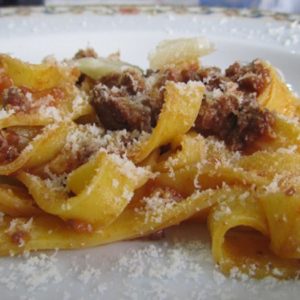
Tagliatelle Alla Bolognese
Ingredients
Ragu alla Bolognese (Sauce)
- 50 grams onion
peeled and chopped finely - 1 tablespoon olive oil
- 50 grams celery
chopped finely - 50 grams Carrot
peeled and chopped finely - 150 grams pancetta
- 300 grams ground beef
Ground flank, sirloin, or chuck beef - ½ glass red wine
the rest for the chef - 300 grams tomatoes crushed
- 6 oz milk
Sfoglia (egg pasta) Tagliatelle
- 100 grams 00 flour
- 60 grams egg
(Italian eggs are huge and are bright beautiful yellow because of the corn that the chickens eat. Normal eggs are smaller than Italian eggs so you might have to use 1.5 eggs- weigh your eggs)
Instructions
Ragu alla Bolognese
- Measurements by weights were very important for this dish. Finely chop onion, carrot, celery and place in a sauce pan to cook with about 3 tablespoons of olive oil for about 10 minutes or until the vegetables are tender and translucent.
- Add the pancetta and cook on low heat for about 10 minutes
- Add the ground beef and brown.
- Stir in the wine and let simmer on low until the wine completely evaporates.
- Add the canned diced tomatoes and cover and simmer of low heat for about 40 minutes. Remember to gently stir the ragu about every 10 minutes and give it a little love.
- Now add the milk and stir until incorporated for a minute or two and then turn off the burner. Set aside while you finish making your pasta by hand.
Sfoglia (egg pasta) Tagliatelle
- Place your flour on your wooden board and make a well for the eggs. Leave a little of the flour on the side to work into the dough later a little at a time.
- Use a fork to scramble the eggs and stir them in slowly to absorb the flour.
- When the dough becomes thick enough, you can start to work the dough gently pressing it with your palms. After each movement, turn it upside and repeat with working the dough gently with your palms of your hands.
- Depending on the humidity, you can start to add just little bits of flour at a time until the dough gets to the perfect consistency. After kneading the dough for about 15-20 minutes your dough will thick and will spring back when you poke it. Set aside your dough under a bowl, protected from air, for at least 20 minutes to rest.
- check consistency of dough, if too wet or too dry work again accordingly.
- Place a little flour on your wooden work surface and place the round dough on top in the middle of your wooden board and flatten gently with your hand. Dust your dough with flour. Use the floured wooden spatula starting at the center of the dough and roll dough gently outwards.
- Repeat the movements of rolling the dough outwards twice and then turn your dough and repeat the process. This is a very difficult process as you do not want to tear the dough and you must get the dough very thin. At some point in time, you must start to use your rolling-pin to move the dough in a counter clock wise direction to finish out the rolling process. (Gently place the dough over the edge of the rolling-pin and roll it up part way and then move the dough sheet 90 degrees counterclockwise and restart the rolling process) The goal is to be able to see through the dough. My benchmark was to be able to read Gabriella's name on her apron through the dough and then I would know that my dough was at the correct thickness.
- Cutting the Tagliatelle egg pasta: Fold the dough over on itself about 4 times in a multi layer cylinder, in about flat 3 inch segment. With a very sharp knife, cut 7-8mm wide pasta noodles. Keep your knife straight up and down. Scraps or shorter noodles can be kept for soups or other dishes.
- Grab about 5-6 strings of Tagliatelle pasta and wrap gently around your palms and set aside and repeat with the remaining pasta. (At this point the pasta can be used fresh in the dish or if you want you can dry the pasta and use for later)
- In a pan of salted boiling water, add your Tagliatelle pasta and cook for about 2 minutes or until aldente. Remove pasta from boiling water.
- Put pasta is a large pan with some of your Ragu all Bolognese sauce and a bit of your pasta water and stir just until incorporated.
- Serve Tagliatelle Alla Bolognese with a grating of fresh Parmesan and enjoy the homemade goodness.


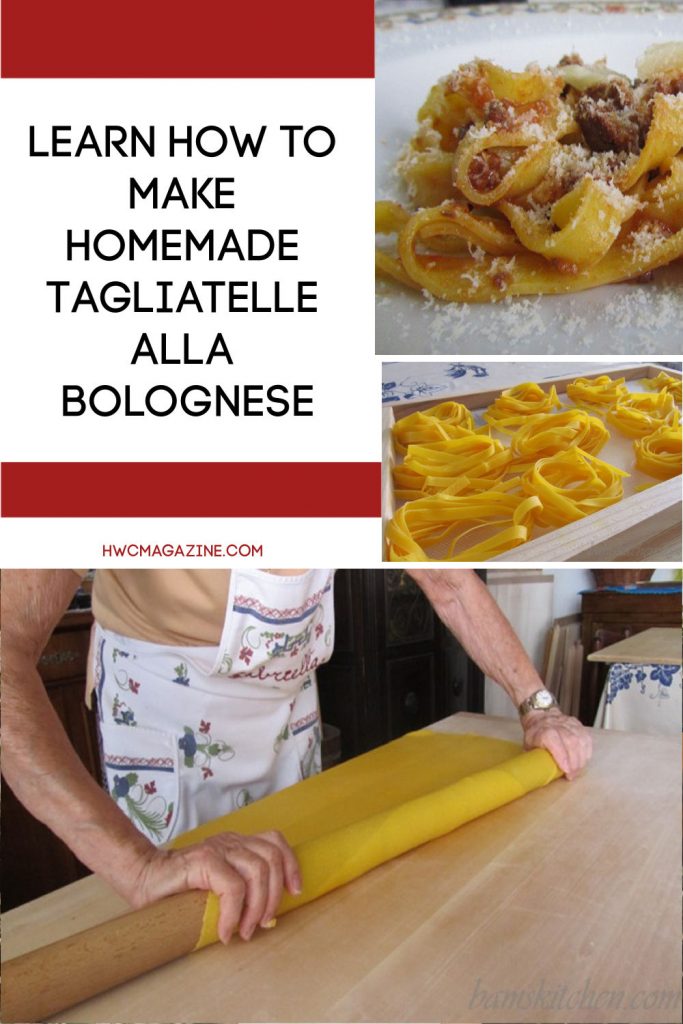
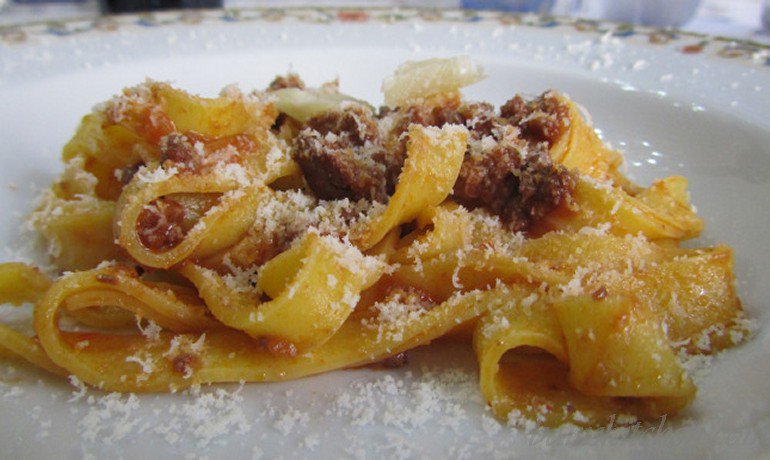
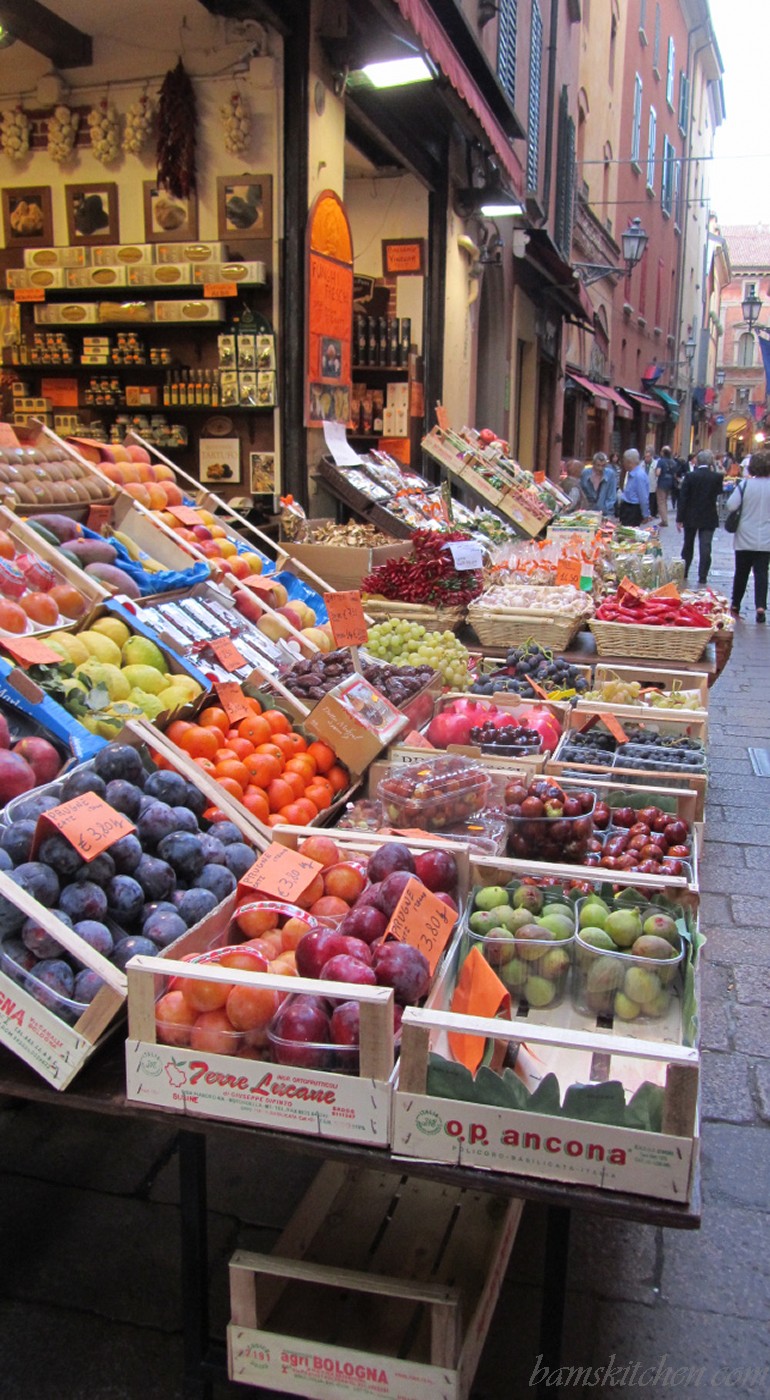
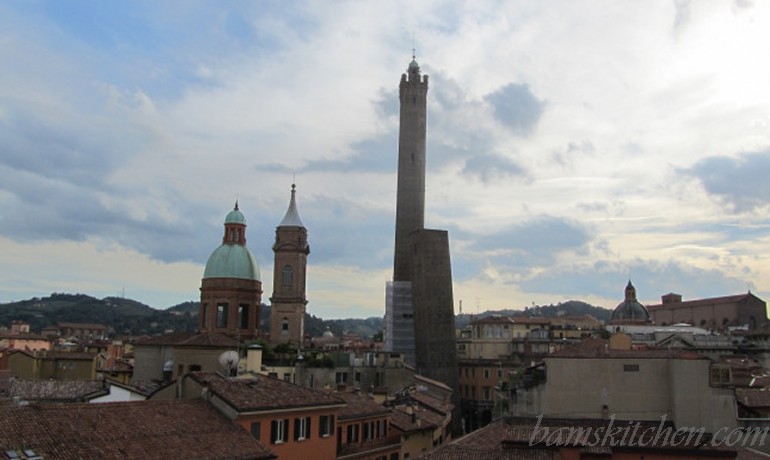
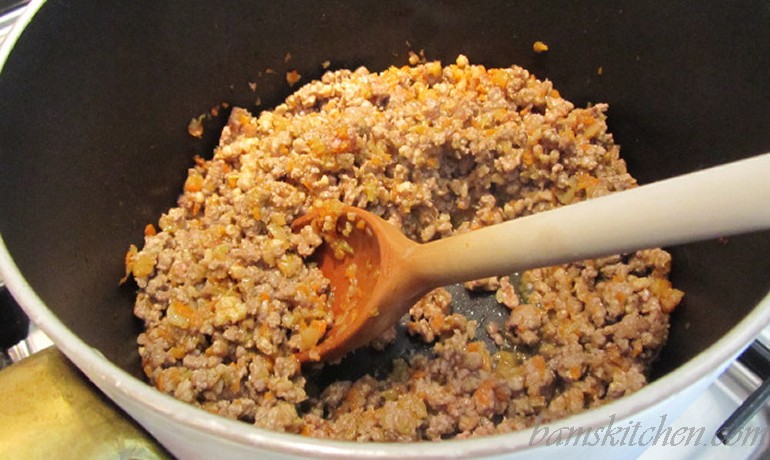
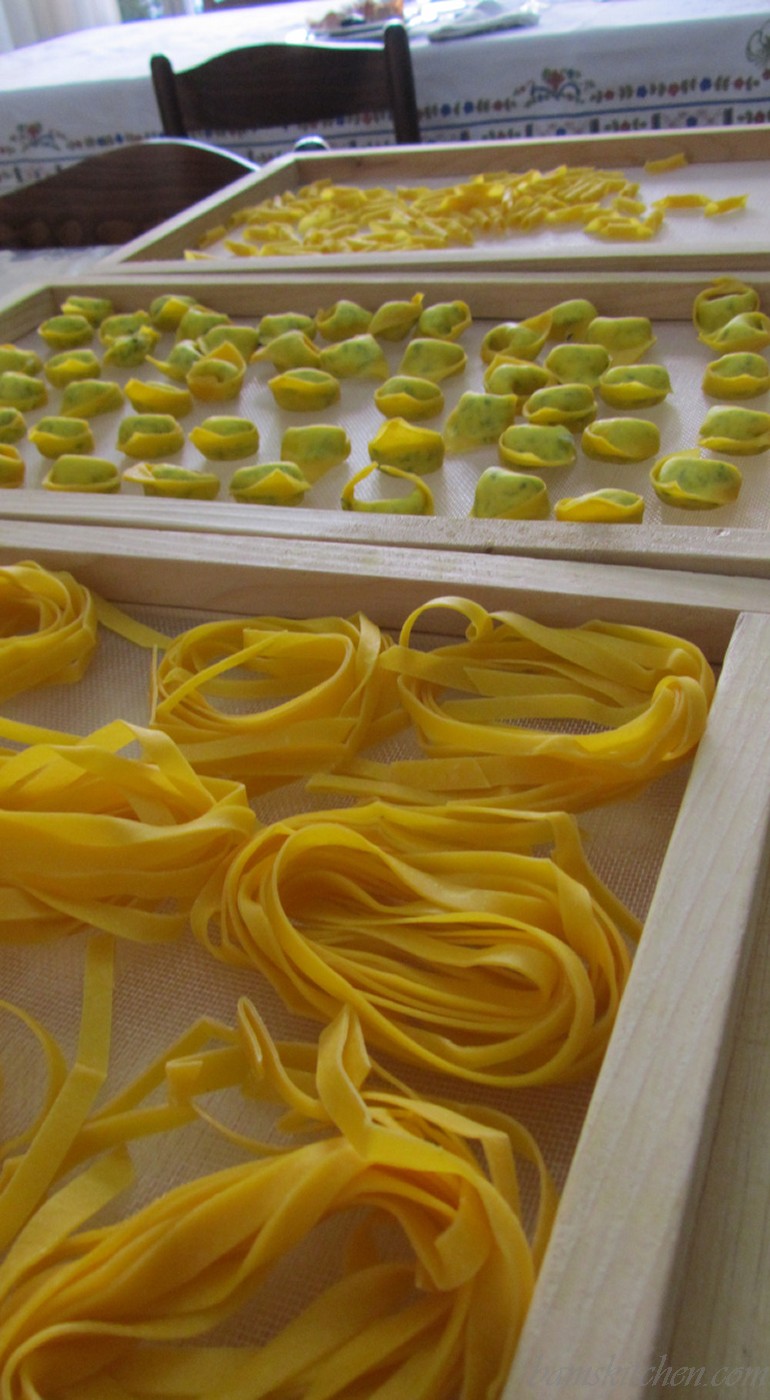
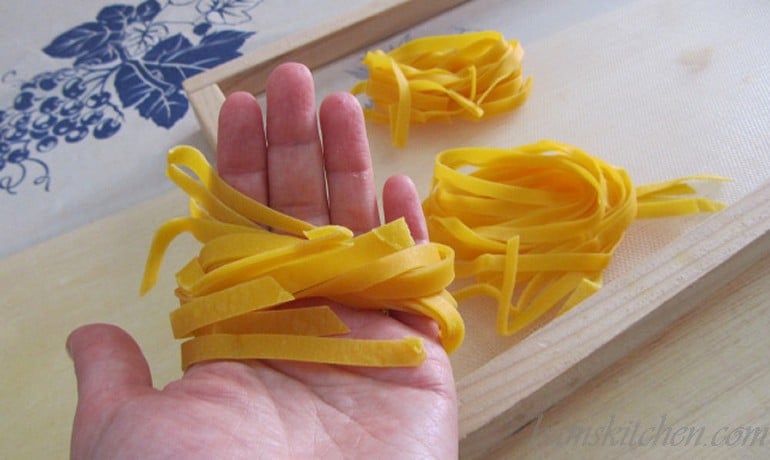
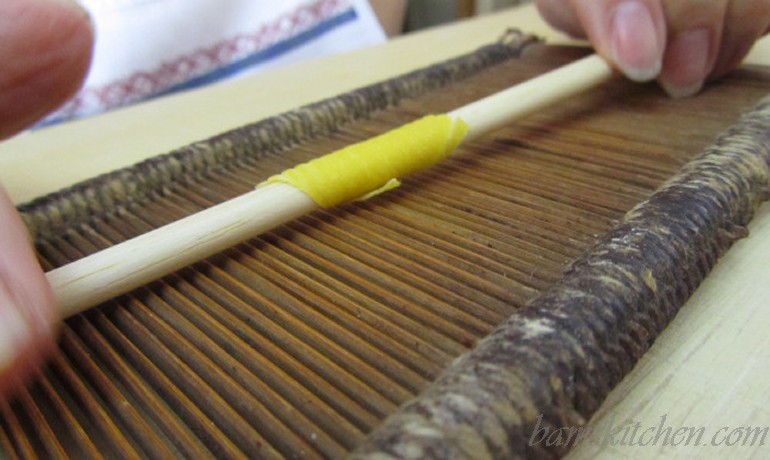
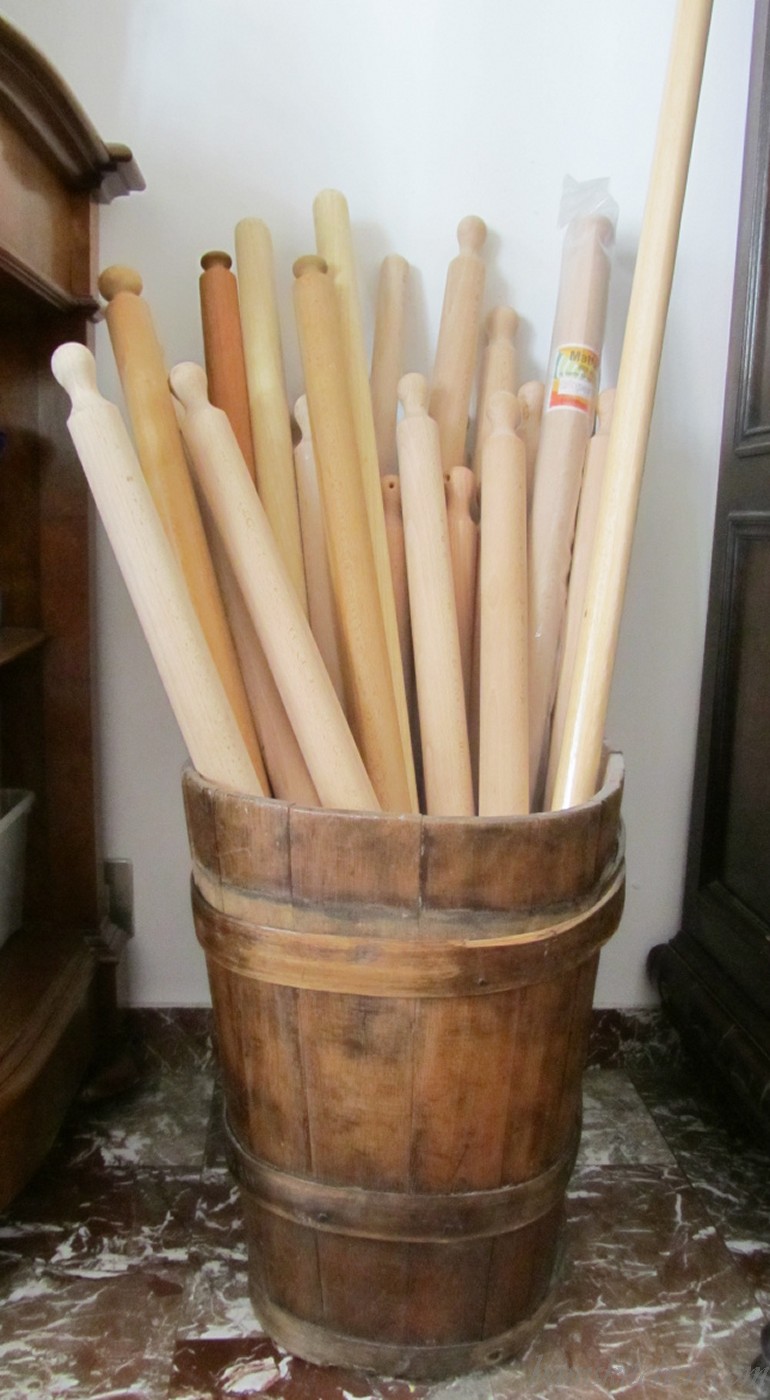
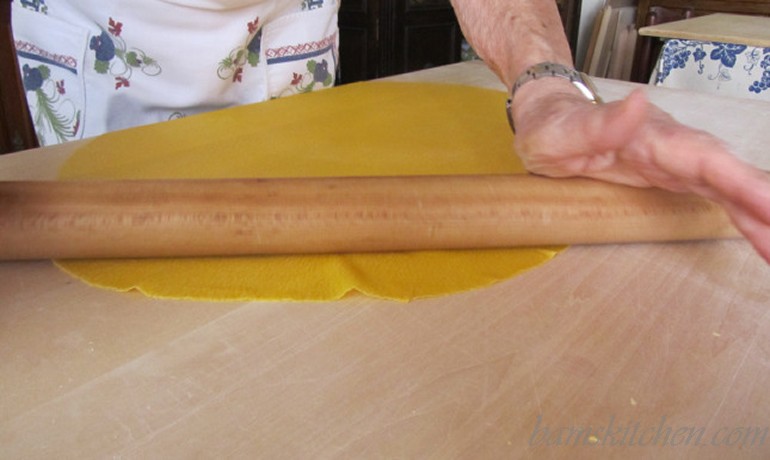
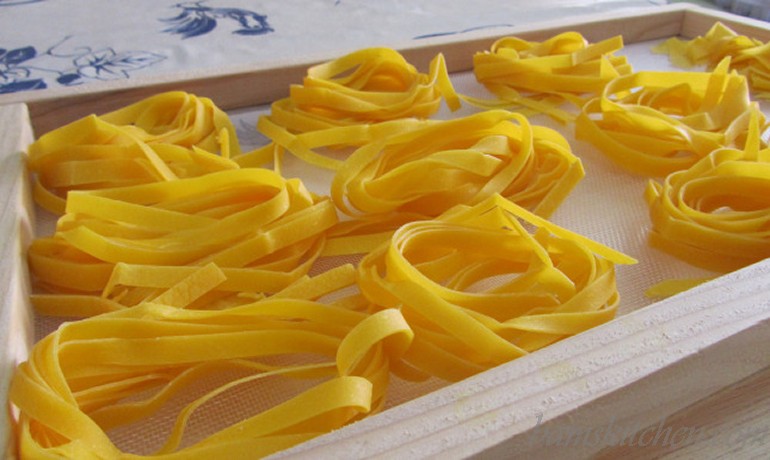
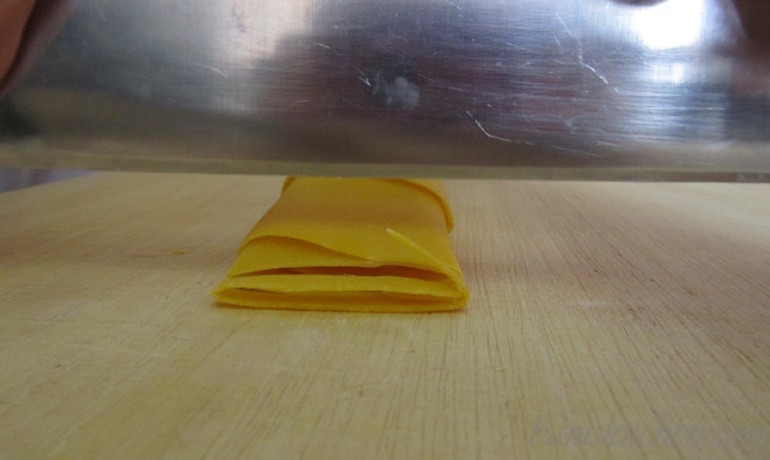
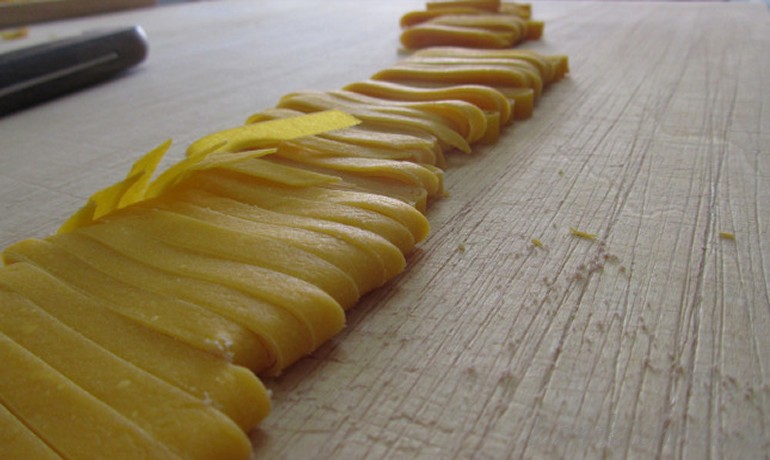
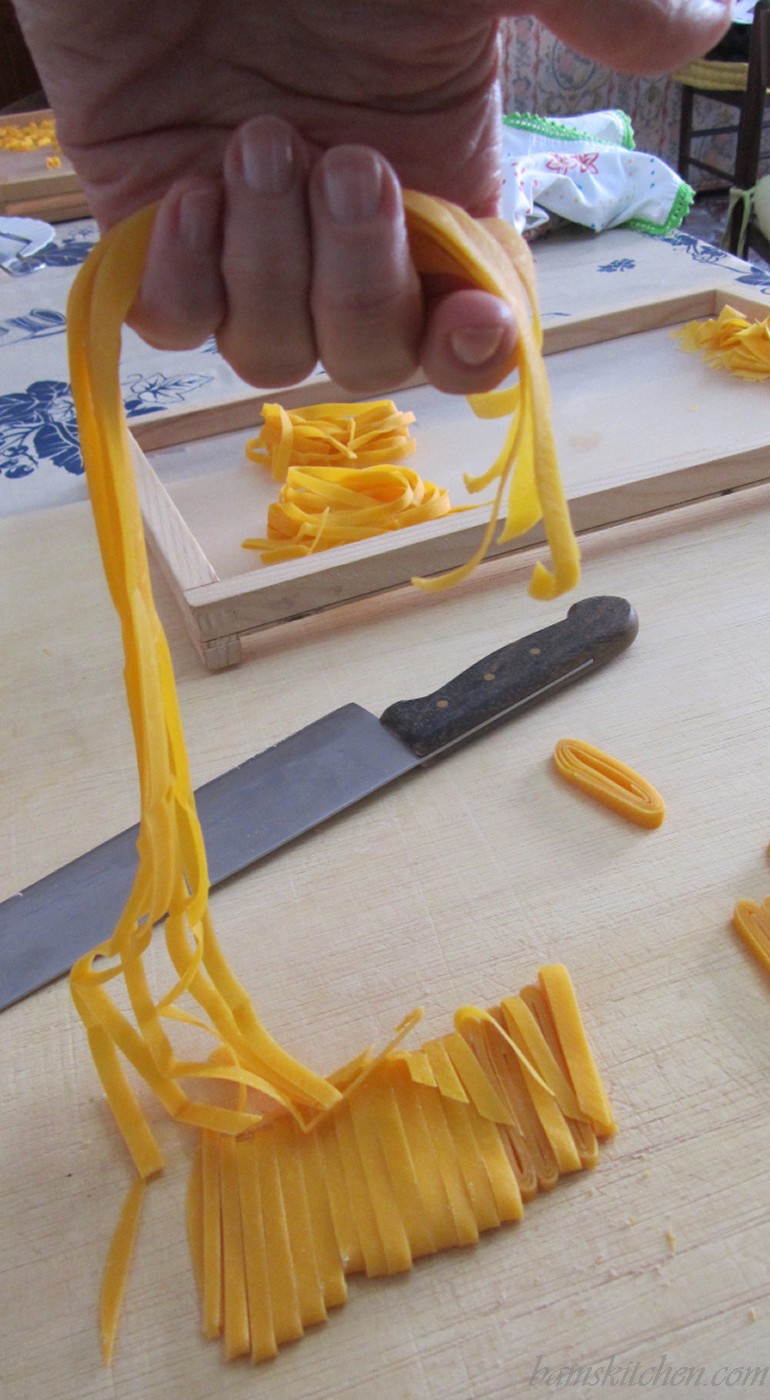
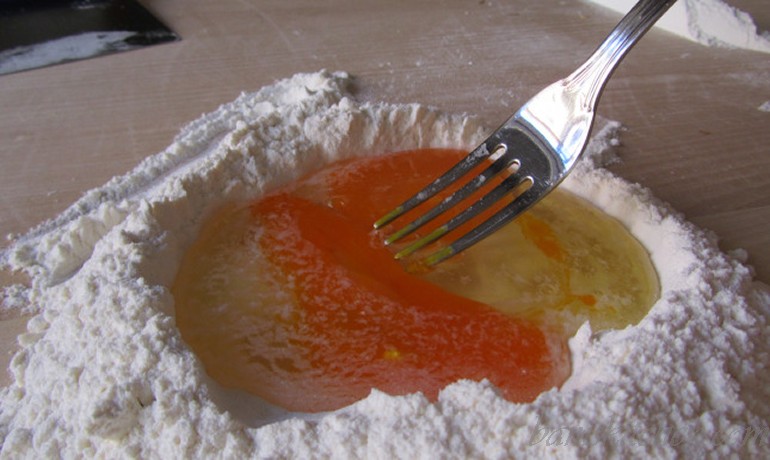
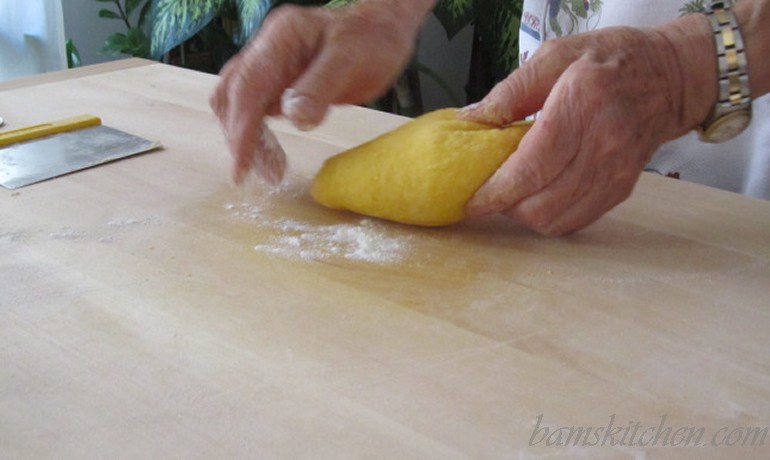
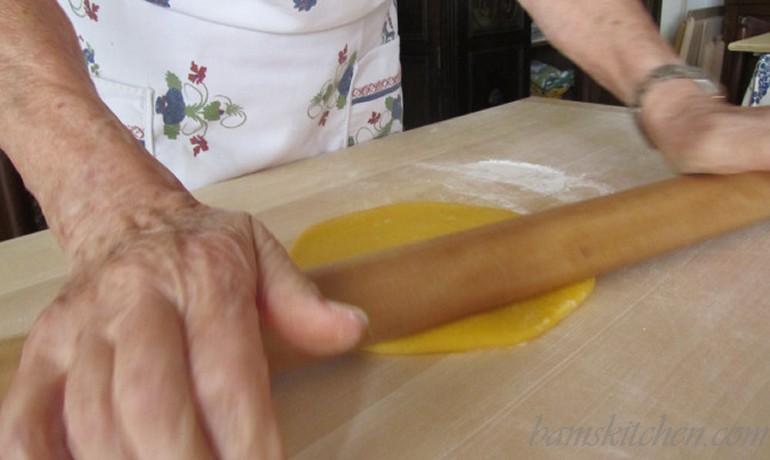
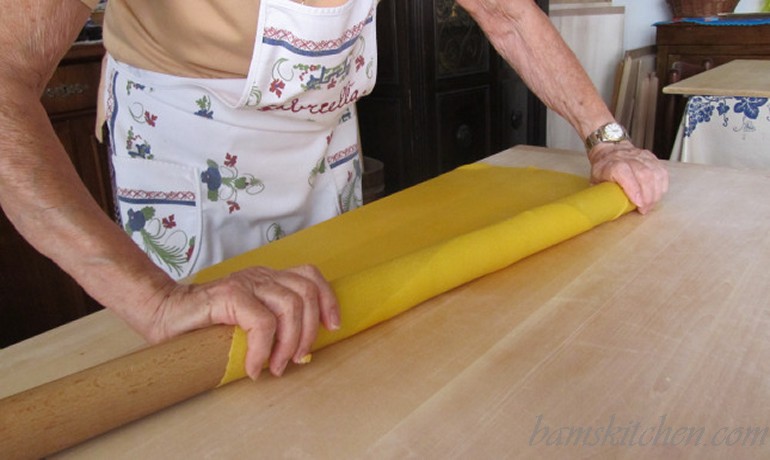
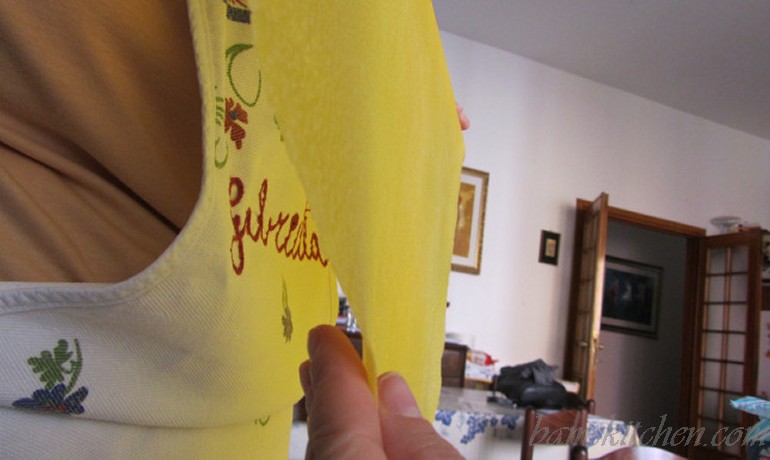

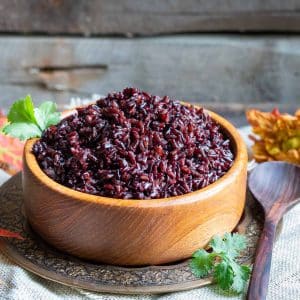
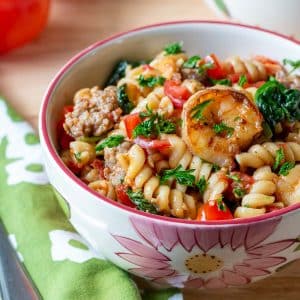


Ian says
Wonderful pasta dish
ioanna aggelidaki says
I should stop checking your blog around meal time........ now my pasta will look so poor in front of yours...... 🙁
Healthy World Cuisine says
Nonsense this gives you an idea for your next meals. Just as your post inspire me. Take care, BAM
Candy @ Candy Girl says
I'm already itching to go back to Italy and then I read your post and now I have to find a way to go back, and soon! I took a similar cooking class when I was in Florence and it was hands down one of my favorite experiences while there. Bologna, and this class, are now on my must visit list. The
Healthy World Cuisine says
Hi Candy, I also visited Florence this year and participated in a class and it was good but the Bologna cooking school was supurb! By a happy accident, I ended up having a private lesson on this day and Gabriella is true little star. Happy Halloween! BAM
Promenade Claire says
Your photos are making me miss mainland Europe. Totally and utterly need to visit and soon!!
Oh and they are making me hungry too 🙂
Healthy World Cuisine says
I can tell you that one cannot go on a diet when visiting Europe with all of that delicious food. I have been on the exercising bandwagon the last 2 weeks on recovery... Take care, BAM
Sawsan@ Chef in disguise says
One of the daring cooks challenges was to make egg pasta and it was amazing and I imagine the one you made in Italy is even better
Thank you for sharing the recipe and the beautiful pictures
Healthy World Cuisine says
Hello Sawson. I think the first time you make pasta it is a very big challenge as you better understand how the dough reacts to your hands, the flour and the moisture. I will have to look your post up and check out your recipe. Take care, BAM
rsmacaalay says
Love to see how those pasta are made, very inspiring seems like I want to do my own
Healthy World Cuisine says
You should give it a try. It takes patience and time but worth every minute. Take care, BAM